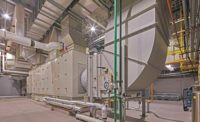Administration officials say they are making a push to incentivize the use of combined heat-and-power, or CHP, energy systems to reduce greenhouse-gas emissions and increase energy efficiency in facilities ranging from Veterans Administration medical centers to industrial plants.
Speaking at the U.S. Clean Heat & Power Association's annual meeting in Washington, D.C., on Oct. 3-4, officials from the White House and the Environmental Protection Agency described recent efforts to encourage greater use of CHP systems, which advocates claim are more efficient than dual-turbine systems. Currently, there are approximately 82 gigawatts of CHP installed in the U.S., according to the USCHPA.
President Obama on Aug. 30 signed an executive order setting a national goal of 40 GW of new CHP capacity by 2020. This goal is "aggressive but achievable" and could spur between $40 billion and $80 billion in capital investment, said Jason Miller, the president's special assistant for manufacturing policy, National Economic Council. "The administration really wants to shine the spotlight on this," he said. Cooperation from state agencies and utilities is "absolutely critical."
States can take credits for CHP efficiencies in their air-quality state implementation plans, said Sarah Dunham, director, EPA office of atmospheric programs. But many states can't quantify those efficiencies or don't have a regulatory framework to encourage CHP, she added. "We are committed to providing assistance to the states on how they can better take advantage of the benefits of CHP," she said.
Some federal agencies have long incorporated CHP goals into their sustainability plans. The Veterans Administration, for instance, plans to build or retrofit at least 40 CHP systems at its medical centers as a way to meet its greenhouse-gas reduction goals for 2020.
The natural-gas boom should boost CHP, Miller said, adding, "We need to think of existing manufacturing plants as a resource that we can ultimately tap [for CHP retrofits]."



